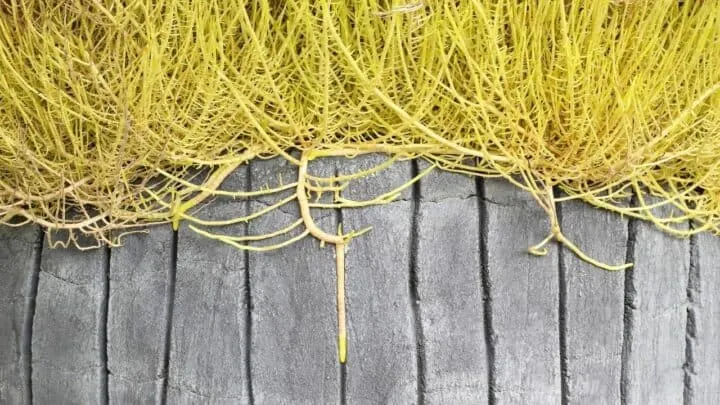Orchids are known by most people as simply being beautiful flowers, but after you plant them, their aerial roots may baffle you.
However, it is perfectly normal for your orchid plant to develop aerial roots, and caring for the roots isn’t as complicated as you may fear.
Although orchids are amongst the largest families of flowers, their tendency to grow air roots may seem unusual when compared to other flowering plants in your garden.
Fortunately, there are a few simple ways to manage your orchid’s aerial roots while still maintaining the health and beauty of the plant.
Table of Contents
What To Do With Orchid Roots
It’s completely normal for orchids to develop aerial roots, so provided the plant is healthy, there’s no need for you to take any action. You should never attempt to remove the roots as doing so could result in harming the plant. However, you can trim the roots if they appear dried out or dead.
Orchid Air Roots Are Normal and Don’t Necessarily Require Any Special Care
Of course, even some seasoned gardeners may become mystified at their orchid developing tendril roots that grow upwards and out of the pot, as this is not common with many other types of flowering plants.
However, since orchids grow on top of trees and other plants when they are in their natural habitat, the formation of aerial roots allows orchids to derive sufficient nutrients from air and rainwater without affecting the plant that the orchid is attached to.
Although aerial roots are unnecessary when an orchid is potted or planted in a garden, the orchid can’t tell the difference and continues to grow aerial roots.
This is absolutely normal development for an orchid. As long as the plant’s otherwise healthy, the aerial roots do not require any specialized care.
You Should Never Try To Remove Healthy Air Roots from an Orchid Plant
Although it may be tempting to just grab a pair of gardening shears and dismember the aerial roots, you should never remove healthy air roots from an orchid plant as this could harm the rest of the plant and leave your orchid vulnerable to viruses that could prove to be detrimental to your plant.
Additionally, the removal of healthy aerial roots could prevent your orchid from being able to absorb the water and nutrients that it needs to continue to grow healthily.
While the aerial roots may appear malformed, they continue to be the portion of the plant that provides nutrients.
Without these roots, your orchid will likely struggle for continued survival and may eventually die.
Trimming Orchid Air Roots That Are Dried Out or Dead
Although trimming or removing healthy orchid air roots is ill-advised, it is okay to trim roots that are dried out and deadened.
However, you will still need to be careful and take certain precautions to avoid harming the rest of the plant.
Since orchids are prone to viruses, you will need to properly sanitize your gardening shears with bleach water or rubbing alcohol prior to removing deadened roots from your orchid.
You should be cautious when trimming and not cut deeply into the plant as doing so could also cause harm to your orchid.
Repotting an Orchid Plant with Air Roots
While orchid aerial roots are completely normal and can occur even when the orchid has been planted in an adequately sized container, an overgrowth of aerial roots may signify the need for a larger pot.
When an orchid plant becomes overcrowded, the roots may continue to further stray from the pot as they seek sufficient room for continued growth.
When repotting your orchid plant in a bigger container, choose a mixture of potting soil that is appropriate for orchid growth, and avoid covering the aerial roots with soil as doing so could result in the roots rotting, which will prevent your orchid from receiving the nutrients that it needs in order to thrive.
Frequently Asked Questions About What To Do With Orchid Roots
How Do I Keep Orchid Roots Healthy?
You can maintain the health of orchid roots simply by watering the plant consistently. If the roots have a white or grayish appearance, you can also try to soak the roots in your kitchen sink for a couple of minutes.
How Should I Get Rid of Orchid Roots?
You can remove deadened orchid roots by gently removing the plant from its container after loosening the soil, wiping away the soil that has accumulated around the root ball, cutting the deadened roots with sterilized gardening shears, and disinfecting the plant’s container prior to replacing the plant.
What Do Unhealthy Orchid Roots Look Like?
Orchid roots that haven’t been sufficiently watered tend to become brittle, while roots that have been overwatered develop a brown or yellow coloring and are usually mushy to the touch. However, it is still possible to save an otherwise healthy orchid plant that has developed deadened roots.
Conclusion
Orchids are beautiful flowers and it’s only natural that you would want to grow them in your home or garden, but their aerial roots may cause you to scratch your head and wonder about proper care.
While you should never trim or remove healthy aerial roots, you should remain mindful of possible overcrowding and carefully remove dried out or deadened roots.
Although aerial roots may give your orchid a unique appeal, they are perfectly normal and only further add to the beauty and character of your orchid.

Daniel has been a plant enthusiast for over 20 years. He owns hundreds of houseplants and prepares for the chili growing seasons yearly with great anticipation. His favorite plants are plant species in the Araceae family, such as Monstera, Philodendron, and Anthurium. He also loves gardening and is growing hot peppers, tomatoes, and many more vegetables.


